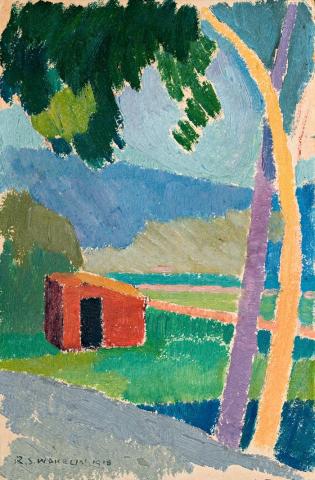LANDSCAPE WITH RED SHED, 1918
Roland Wakelin
oil on card
17.0 x 11.0 cm
signed and dated lower left: R. S. WAKELIN 1918
Mr. John Young, Sydney
Thence by descent
Private collection, Sydney
Sotheby's, 21 November 2006, lot 148
Private collection, Melbourne
Landscape with Red Shed, 1918, belongs to a classic and much sought after period in Wakelin's art. Memorable works from 1918 include Boat Sheds and The White House in the collection of the Newcastle Region Art Gallery, and The Yellow House, once in the collection of the late Lloyd Rees. The same quality found in these little masterpieces continued in such works of 1919 in the collection of the Art Gallery of New South Wales - Berry's Bay, and Synchromy in Orange Major.
The year 1918 was significant in several ways. Wakelin and Roy de Maistre became interested in colour theory and its relationship to music, the two holding an exhibition of synchromies or colour music the following year at Gayfield Shaw's Art Salon. Wakelin showed six landscapes; and as no catalogue was provided, one can only speculate whether this painting was exhibited. In style and palette, it qualifies to be included among those rare gems of Wakelin's colour music paintings. Wakelin and de Maistre also painted several abstract works, credited with being the first in Australia. On the more personal side, Wakelin met John Young in 1918. Young had a picture framing business in Sydney's Little George Street. It became a daily meeting place for artists. In 1922, when Wakelin first visited Paris, Young joined him. In 1925, Young chose an exhibition of Wakelin's paintings of London and Paris to inaugurate the Macquarie Galleries in Bligh Street, Sydney, co-founded with Basil Burdett. The catalogue introduction was written by Margaret Preston and it was to be the first of many exhibitions held by Wakelin at the Macquarie over the following years.
Landscape with Red Shed resonates with colour, the delicate mauves and harmoniously interrelated passages of blues and greens evoking musical associations, contrasting with bolder oranges and accents of red. The technique adds a vivacious touch, giving it all the immediacy of a passage of music, pleasing of tone and mood. As Douglas Dundas wrote in Art and Australia in 1967, 'The small paintings of this period are unique and quite beautiful.'1 History reminds us, however, that Wakelin's early work was greeted with scorn and vindictive, Wakelin himself recalling that the 1918 exhibition of several of his works, including Boat Sheds, together with two by Grace Cossington Smith, was described by one critic as 'a corner for deliberate frightfulness.'2
The provenance of this painting adds to its aesthetic and historical interest for, as we have seen, Wakelin had a long and close association with John Young.
1. Dundas, D, 'Roland Wakelin', Art and Australia, vol. 4, no. 4, March 1967, p. 278
2. Wakelin, R, 'Recollections of a Post-Impressionist', ibid., p. 291
DAVID THOMAS
